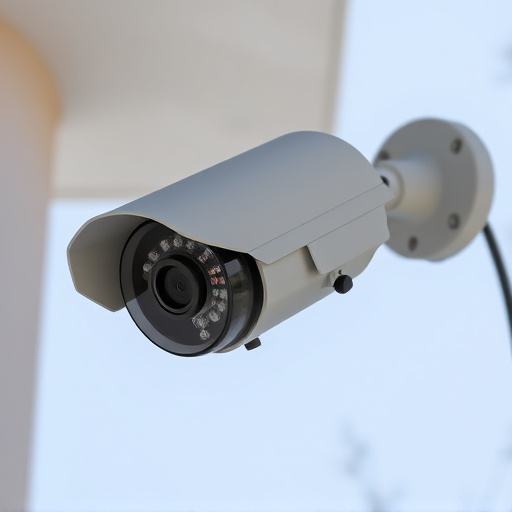Infrared (IR) sensors, essential for night vision and security, are being counterfeited by dummy cameras mounted under eaves. While these fakes offer no real protection, genuine IR sensors emit light and capture reflected signals for accurate motion detection in low-light conditions. Mounting dummy cameras under eaves provides strategic coverage, deterring intruders with a visible presence while maintaining privacy with adjustable brightness and wavelength settings. Regular testing and secure wiring are crucial for optimal performance and reliability in outdoor installations.
In the realm of home security, a strategic approach to deterring potential intruders involves utilizing fake camera infrared sensor LEDs. This article delves into the intricate world of these dummy cameras, offering insights on understanding their functionality and optimizing security measures. We explore the benefits of mounting these cameras under eaves, highlighting how they can effectively mimic real surveillance systems. Additionally, we provide guidance on choosing the right LED technology and installation tips to ensure optimal performance and enhanced safety.
- Understanding Fake Camera Infrared Sensors and Their Functionality
- Benefits of Mounting Dummy Cameras Under Eaves
- Choosing the Right LED Technology for Optimal Performance
- Installation Tips and Best Practices for Effective Security Measures
Understanding Fake Camera Infrared Sensors and Their Functionality
Infrared (IR) sensors are an essential component in many modern camera systems, enabling them to capture images beyond the visible light spectrum. However, there’s a growing trend where fake or dummy IR sensors are being installed, often through mounting dummy cameras under eaves or other hidden locations. While these mimic the external appearance of functional IR sensors, they lack the internal components necessary for actual infrared detection and imaging.
This practice is particularly prevalent in areas seeking to deter burglars or vandals without investing in robust security systems. However, it’s crucial to understand that fake IR sensors provide no real security benefits and can even give a false sense of security. They remain passive, unable to detect motion or heat signatures, making them easily outsmarted by determined intruders. In contrast, genuine IR sensors are designed to actively emit infrared light and capture reflected signals, allowing for accurate and reliable detection in low-light conditions.
Benefits of Mounting Dummy Cameras Under Eaves
Mounting dummy cameras under eaves offers several notable advantages for security and surveillance. This strategic placement allows for comprehensive coverage of your home’s exterior, particularly blind spots that traditional camera setups might miss. By installing these cameras beneath eaves, you gain a bird’s-eye view of your property, making it easier to detect potential threats or suspicious activity.
Furthermore, dummy cameras under eaves serve as a powerful deterrent to intruders. Their conspicuous presence can discourage would-be criminals from targeting your home. Even if the sensors are not actively recording, the mere sight of these devices can create an illusion of heightened security, thereby enhancing the overall safety of your living space.
Choosing the Right LED Technology for Optimal Performance
When selecting LED technology for dummy cameras designed to mimic real infrared sensors, it’s crucial to consider wavelength and power output. Different LEDs emit light at specific wavelengths, with IR LEDs targeting the 850nm range, ideal for low-light visibility without revealing the camera’s presence. Power output measures in mW (milliwatts) determine the sensor’s range and effectiveness; higher power outputs offer longer detection distances but may require more heat management to prevent damage.
For optimal performance when mounting dummy cameras under eaves or other hidden locations, choosing LEDs with adjustable brightness and customizable wavelength settings allows fine-tuning for specific applications. This flexibility ensures the fake infrared sensor accurately mimics real camera activity while maintaining discreetness. Additionally, considering environmental factors like temperature fluctuations and moisture exposure is essential for long-term reliability in outdoor installations.
Installation Tips and Best Practices for Effective Security Measures
When installing dummy cameras, particularly those designed with infrared sensors, strategically mounting them under eaves is a smart security practice. This location offers several advantages: it keeps the camera concealed from potential intruders and provides optimal visibility for detecting movement or unusual activities around your property. Ensure the camera has a clear view of the entranceways, garages, or areas you want to monitor. The infrared LED technology allows for night vision capabilities, making it an effective tool for round-the-clock security.
During installation, pay close attention to the camera’s angle and positioning. Aiming it slightly downwards under the eaves ensures a broader field of view without capturing too much sky, which can obscure your view during low-light conditions. Regularly test the camera’s sensitivity and motion detection to ensure accurate activation in response to potential threats. Additionally, keep the camera’s wiring secure, hidden from view, and well-protected to prevent damage or tampering.
Infrared (IR) dummy cameras, strategically mounted under eaves using the right LED technology, offer an effective and affordable security solution. By understanding the functionality of fake camera IR sensors and implementing best installation practices, homeowners can enhance their property’s security without breaking the bank. Benefits like improved crime deterrence and peace of mind make investing in mounting dummy cameras under eaves a smart choice for anyone seeking robust outdoor surveillance.
